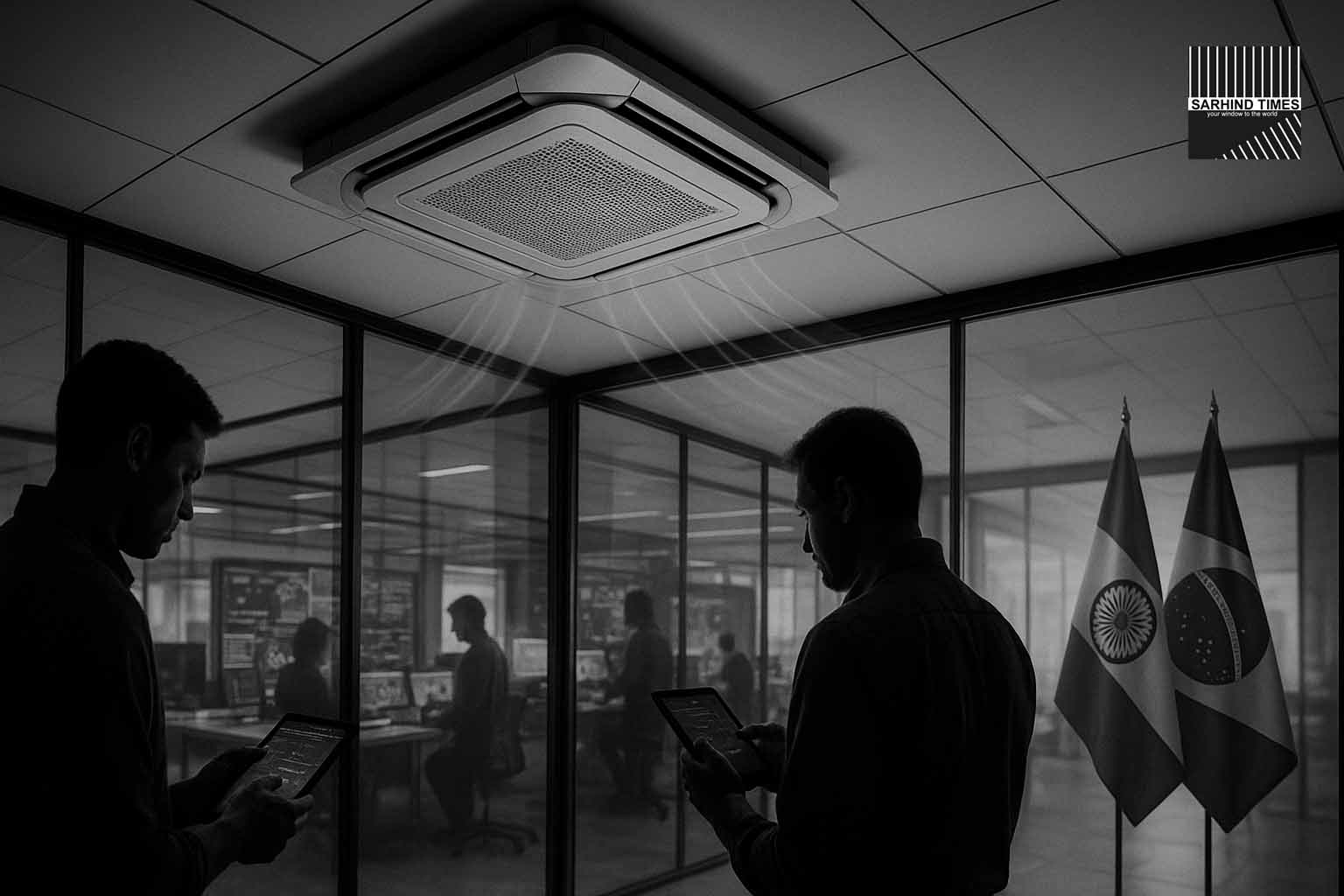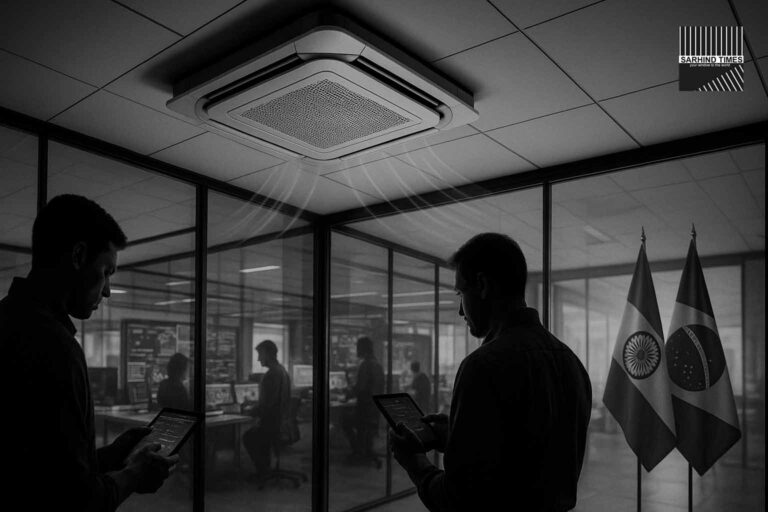By Sarhind Times Bureau | New Delhi | October 15, 2025
Introduction: Cooling Innovation, Made in India
South Korean technology giant Samsung has expanded its Indian manufacturing portfolio with the launch of its latest WindFree cassette air conditioners, designed for commercial and institutional use. Manufactured entirely in India, these new models mark a significant stride in localised innovation, smart connectivity, and energy efficiency, positioning the country as a major production and R&D hub in Samsung’s global HVAC (Heating, Ventilation, and Air Conditioning) network.
The launch, reported by Moneycontrol, underscores how India’s Make-in-India initiative and rising green-building demand are reshaping industrial manufacturing strategies. These new AC systems combine SmartThings connectivity, AI-based automation, and R32 refrigerant—offering up to 48% energy savings while reducing environmental impact.
“The WindFree cassette AC represents the convergence of sustainability, intelligence, and local manufacturing strength,” said Sungwan Lee, President & CEO, Samsung Southwest Asia.
Product Overview: WindFree, Smart, and Efficient
The newly launched WindFree cassette AC models are tailored for commercial spaces such as offices, educational institutions, hospitals, and retail outlets.
The design uses WindFree Cooling™ technology, which disperses cool air through 23,000 micro-holes, eliminating direct drafts while maintaining uniform temperature.
🔹 Key Features:
- SmartThings Integration: Allows remote monitoring, scheduling, and energy optimisation through Samsung’s IoT platform.
- R32 Refrigerant: A low global warming potential (GWP) refrigerant aligned with India’s green cooling roadmap.
- AI Auto Cooling: Learns operational patterns to optimise comfort and reduce energy waste.
- Energy Savings: Up to 48% energy efficiency improvement over conventional systems.
- Predictive Maintenance: AI sensors detect anomalies and alert maintenance teams before breakdowns occur.
“This is more than an AC; it’s a connected climate-control ecosystem,” said Saurabh Bansal, VP, Consumer Electronics Division, Samsung India.
Make-in-India Milestone: Manufacturing and R&D Synergy
The WindFree cassette ACs are being manufactured at Samsung’s Noida facility, one of the company’s largest global production bases.
This facility now produces not only consumer electronics and appliances, but also commercial-grade HVAC systems aimed at both domestic and export markets.
The manufacturing strategy reflects Samsung’s “India-for-India and India-for-Global” model, where R&D, design, and production integrate to serve global standards with local efficiency.
“Our HVAC R&D team in Noida has adapted WindFree technology for India’s climate and energy grid,” said a senior Samsung India engineer. “We are localising components, from compressor calibration to printed circuit boards.”
Technology Deep Dive: The Science Behind WindFree
Traditional cassette air conditioners use direct airflow, which can lead to cold drafts and uneven cooling.
Samsung’s WindFree technology addresses this with a two-stage operation:
- Fast Cooling Mode: Rapidly lowers temperature through direct airflow.
- WindFree Mode: Switches to micro-hole dispersion, maintaining comfort without airflow discomfort.
Additionally, the system employs:
- Inverter compressors with variable speed drive.
- Tri-Care filtration to trap dust and allergens.
- Smart load sensing to adjust performance based on occupancy and humidity.
Combined with AI pattern learning, this setup ensures optimized cooling with minimal energy consumption, a major step toward sustainable HVAC design.
SmartThings Integration: The IoT Edge
Through Samsung’s SmartThings ecosystem, users can control, schedule, and monitor AC units remotely using smartphones or central building management dashboards.
Capabilities include:
- Fleet Monitoring: Track performance of multiple units across sites.
- Predictive Alerts: Receive early notifications for maintenance.
- Custom Automation: Integrate with lights, sensors, and smart meters for synchronised operation.
- Usage Analytics: View consumption history and energy reports.
“For large campuses, SmartThings transforms air conditioning into an intelligent, self-managing service,” said Rohit Pathak, Head of B2B Solutions, Samsung India.
Sustainability Focus: Efficiency Meets Responsibility
The new ACs align with India’s Energy Conservation Building Code (ECBC) and Bureau of Energy Efficiency (BEE) standards.
🌿 Sustainability Highlights:
- R32 Refrigerant: 68% lower global warming potential than R410A.
- Energy Monitoring: Smart analytics help organisations stay within consumption budgets.
- Reduced Carbon Footprint: Optimised power draw reduces load on urban grids.
- Lifecycle Durability: Longer component lifespan cuts e-waste and replacement frequency.
“Our approach is to merge performance with responsibility,” said Sungwan Lee. “Sustainability is no longer a feature—it’s our foundation.”
Commercial Target Market: Offices, Retail, and Institutions
The WindFree cassette ACs are targeted toward:
- Corporate offices requiring zonal control.
- Hospitals and universities prioritising consistent airflow.
- Retail stores and malls seeking centralised control for energy savings.
- Institutional campuses adopting green-building certifications (LEED, GRIHA).
Dealers report growing interest from real estate developers and facility management firms, especially as ESG compliance and green codes become mandatory in upcoming infrastructure projects.
“Smart HVAC systems are the backbone of modern commercial sustainability audits,” said Anil Khanna, President, Indian Green Building Council (IGBC).
Market Context: A Competitive, Fast-Growing Segment
India’s HVAC market, valued at $8.2 billion in 2024, is projected to exceed $13 billion by 2028, according to Frost & Sullivan.
Growth is driven by:
- Rising commercial real estate construction.
- Government efficiency mandates.
- Corporate sustainability goals.
- Rising temperatures and climate unpredictability.
Samsung’s latest launch comes amid intensifying competition from Daikin, LG, Carrier, and Blue Star, all investing in smart and energy-efficient solutions.
“Samsung’s advantage lies in its SmartThings ecosystem and IoT depth,” said Prateek Sharma, senior HVAC analyst. “Their ACs aren’t just cooling systems—they’re connected assets.”
India’s Role in Global Supply Chain
The new WindFree cassette AC line will serve not only Indian clients but also export markets in South Asia, the Middle East, and Africa.
India’s strategic manufacturing capability enables Samsung to:
- Reduce dependence on imports from East Asia.
- Benefit from PLI (Production Linked Incentive) schemes.
- Develop local vendor ecosystems for components like compressors and heat exchangers.
“India’s HVAC exports can grow exponentially if companies invest in R&D and standardisation,” said Ramesh Nair, CEO, Electronics Manufacturing Association of India (EMAI).
Green Buildings and Policy Alignment
The government’s Energy Conservation (Amendment) Act 2022 mandates energy-efficiency improvements in large commercial installations.
Samsung’s new ACs directly support these initiatives, offering compliance with:
- BEE Star Rating System.
- LEED/GRIHA green-building certification.
- Corporate ESG targets under CSR frameworks.
“Green HVAC systems are now policy instruments,” said Dr. Nirmala Reddy, energy policy researcher. “Products like Samsung’s WindFree bridge the policy-to-product gap.”
Channel Strategy and Rollout
Samsung’s B2B and channel partners confirm that rollout begins this week across key metro and tier-2 markets, including:
- Delhi NCR
- Bengaluru
- Hyderabad
- Mumbai
- Ahmedabad
Pricing will vary by tonnage (1.5–5 TR) and installation configuration, with options for ceiling, four-way, and ducted cassette designs.
Samsung plans to expand service networks and training programs for installers and technicians to ensure standardised performance.
Analyst View: The Convergence of Tech and Climate Control
Industry analysts view this launch as part of a larger shift toward connected infrastructure—where air conditioning is as much a data service as a utility.
“The HVAC industry is digitising,” said Kunal Dholakia, Director, GlobalData Analytics. “Samsung’s SmartThings integration makes climate management predictive and programmable, not reactive.”
Experts also highlight how such innovations can reduce operational expenses by up to 20% for facility managers through real-time energy monitoring and predictive upkeep.
Consumer Experience: Comfort Without Compromise
Field tests conducted at Samsung’s partner facilities report:
- Reduced noise levels (below 45 dB) even at full load.
- Uniform temperature control with no cold spots.
- Seamless switching between cooling modes.
“WindFree has changed how commercial cooling feels,” said Rahul Mehta, facilities manager at a Gurugram IT park. “It’s quiet, consistent, and smart enough to adjust without intervention.”
Conclusion: India at the Heart of Cooling Innovation
Samsung’s new WindFree cassette AC line represents more than another product launch—it’s a statement of technological leadership rooted in local innovation.
By integrating AI, sustainability, and IoT, the company is redefining how cooling systems fit into India’s energy-efficient, digitally connected future.
As the world warms and energy demands soar, India’s capability to produce such next-generation systems domestically strengthens both its economy and environmental resilience.
From factories in Noida to skyscrapers in Mumbai, “Made in India” now means smart, sustainable, and globally competitive.
#MakeInIndia #HVAC #SmartThings #EnergyEfficiency #Samsung #GreenBuilding #Innovation #Sustainability #DigitalIndia #SarhindTimes




















+ There are no comments
Add yours